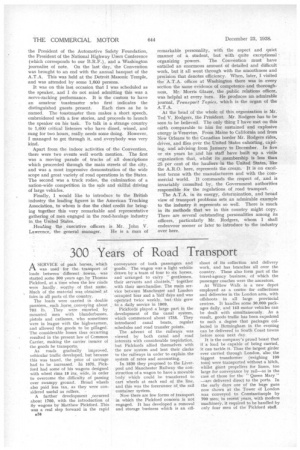300 Years of Road Transport
Page 36

If you've noticed an error in this article please click here to report it so we can fix it.
ASERVICE of pack horses, which was used for the. transport of loads between different towns, was started some 300 years ago ,by Thomas Pickford, at a time when the few roads were _hardly worthy of that name. Much of the material was obtained at fairs in all parts of, the country.
The loads were carried in double panniers,. each _horse. conveying about 703 lb. They were escorted by mounted men with blunderbusses, pistols and cutlasses, who sometimes were in league with the highwaymen, and allowed the goods to be pillaged. The considerable losses thus occurring resulted in the present law of Common Carrier, making the carrier insurer of the goods he transports.
As roads gradually improved, vehicular traffic developed, but because this was taxed, the price of carriage had to be increased. In 1675, Bickford had some of his wagons designed with wheel rims 18 ins, wide, in order to overcome the difficulty of passing over swampy ground. Broad wheels also paid less tax, as they were considered useful as rollers.
• A further development ,occurred about 1760, with the introduction of fly wagons by Matthew Pickford. This was a real step forward in the rapid 434 conveyance of both passengers and goods. The wagon was a light vehiele drawn by a team of four to six horses, and arranged to carry" gentlemen, their servants and chattels," together with their merchandise. The main service between Manchester and London occupied four and a half days and was operated twice weekly, but this grew to a daily service in 1809.
Pickfords played a large part in the development of the canal system, which commenced about .1755. They introduced canal boats, regular schedules and road transfer points.
The advent of the railways was viewed by both canal and road interests with considerable trepidation, but Pickfords allied themselves with the new system and lent their clerks to the railways in order to explain the system of rates and accounting.
In 1830 they proposed to the Liverpool and Manchester Railway the construction of a wagon to have a movable body which. could be transferred to cart wheels at each end of the line, and this was the forerunner of the rail container system.
Now there are few forms of transport in which the Pickford concern is not engaged. It has developed a removal and storage business which is an off
shoot of its collection and delivery work, and has branches all over the country. These also form part of the travel-agency business, of which the passenger coaches were the ancestors.
At Willow Walk is a new depot employed as a centre for collections and deliveries in the London area, with offshoots in all large provincial centres. It handles some 30,000 packages daily, and 143 motor vehicles can be dealt with simultaneously. As a • result, goods traffic has been expedited to such a degree that packages collected in Birmingham in the evening can be delivered in South Coast towns before noon next day.
It is the company's proud boast that if a load be capable of being carried. it can tackle it. Thus the largest girder ever carried through London, also the biggest transformer (weighing 109 tons) were transported without a hitch, whilst giant propellers for liners, too large for conveyance by rail—as in the case of those for the " Queen Mary " —are delivered direct to the ports. In the early days one of the tinge guns now shown at the Tower of London was conveyed to Constantinople by 700 men; in recent years, with modern machinery, it required to be handled by only four men of the Pickford staff.




































































